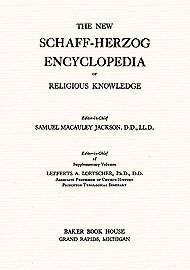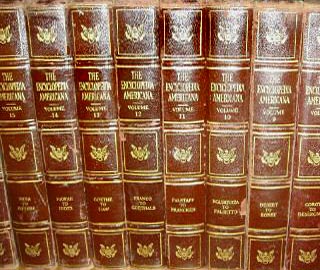
SPALDING STUDIES LIBRARY -- SPECIAL COLLECTIONS
Sp. Col. Index | Mormon Classics | Bookshelf | Newspaper Articles | History Vault
|
Jackson, Samuel Macauley (editor) & Van Pelt, J. R. (primary writer) "Mormons" article in: New Schaff-Herzog Encyclopedia 1910 |

|
|
|
Editorial Notes: The current work is a revised edition of Philip Schaff, et al., A Religious Encyclopedia... Based on the Real-Encyklopadie of Herzog... published by Funk & Wagnalls between 1882 and 1884. The article on the "Mormons" in that edition was revised and updated (primarily by Dr. J. R. Van Pelt) for the 1903 printing, and then updated again c. 1909 for the current edition, published between 1910 and 1914. Van Pelt's article reflects the opinions of secular and Protestant scholars of Mormonism at the beginning of the 20th century. In terms of attributing possible non-Nephite origins for the Book of Mormon, the Van Pelt article incorporates the views of writers as diverse William A. Lynn (a Solomon Spalding claims traditionalist) and I. Woodbridge Riley (who argued for a Joseph Smith psycho-biographical basis and publicized the influence from Ethan Smith's writings). Along with the contemporary publication of rather similar origins explanations in the 1911 edition of the Encyclopedia Britannica, the Schaff-Herzog's hesitant use of the traditional claims marked the end of religious historians' sympathetic citation of Spalding authorship explanations for the Book of Mormon in standard reference works. | ||
|
THE NEW SCHAFF-HERZOG ENCYCLOPEDIA OF RELIGIOUS KNOWLEDGE Editor-in-Chief SAMUEL MACAULEY JACKSON, D.D., LL.D. Editor-in-Chief of Supplementary Volumes LEFFERTS A. LOETSCHER, Ph.D., D.D. Associate Professor of Church History Princeton Theological Seminary [New York, London] [Funk and Wagnalls Company] [1910] |
MORMONS.
|
|
|
|
|
|
|
|
|
|
|
|
|
|
McDannald, A. H. (editor) "Book of Mormon" article in: Encyclopedia Americana 1948 |

|
|
THE ENCYCLOPEDIA AMERICANA EDITOR IN CHIEF A. H. McDannald, B.L. In Thirty Volumes [ ] 1948 Edition AMERICANA CORPORATION * NEW YORK * CHICAGO |
|
232 BOOK OF MORMON. A work first published by Joseph Smith in 1830 and alleged to be the English translation of an ancient record, embodying the history and more particularly the religious beliefs and practices, of the aboriginal peoples of the American continent. The period covered by the main history is approximately 1,000 years, beginning with 600 B.C., in which year a small company of Israelites left Jerusalem by Divine direction, under the leadership of the prophet Lehi. These people reached the Arabian shore, where they constructed a vessel in which they crossed the waters to the Western continent. The colony developed into two opposing nations, Nephites and Lamanites, named after their respective chieftains, Nephi and Laman. The Nephites cultivated the arts of civilization and kept a written history which was engraved by a succession of scribes on thin plates of gold. The Lamanites led a nomadic life, depended for subsistence mainly upon war and the chase, and in time degenerated into the dark-skinned race of which the American Indians are said to be the descendants. The Nephites were exterminated by their Lamanite foes about 400 A.D. The voluminous Nephite records were abridged and summarized by Mormon, one of the later prophets, who gave the abridgment his own name: hence the title "Book of Mormon." The original classification into distinct books, each designated by the name of its principal author, was preserved by Mormon in his shorter history; and the modern version appears as a compilation of 15 such books. Mormon's son, Moroni, survived the destruction of his people long enough to continue the record left by his father, with which he incorporated the 'Book of Esther,' [sic - Ether?] which appears as an abridged history of a colony that had been miraculously brought to America from the Tower of Babel soon after the dispersion. Moroni deposited the records together with certain other articles of sacred import in a stone box, and this he buried in a hill near Palmyra, Wayne County, in the State of New York, which hill is called in the text Cumorah. Joseph Smith, founder of the Mormon Church, the official designation of which is "The Church of Jesus Christ of Latter-day Saints," solemnly affirmed that in September 1823 the existence of the records was made known to him by an angelic visitant, who announced himself as Moroni, the last historian and prophet of the extinct Nephite nation, and that four years later Moroni delivered to him the plates of gold with the commission to translate certain portions, for which labor he had been qualified through the gift and power of 233 God. With the plates were two stones, set in the ends of a bow of metal; these, as Moroni explained, were the Urim and Thummim; and Joseph Smith averred that by their aid he was enabled to translate the ancient characters into English. The 'Book of Mormon' comprises 623 pages, averaging 425 words to the page. From the English version translations have been made into 15 tongues. Among the many assumptions advanced in purported explanation of the origin of the Book of Mormon and in hostile denunciation of Joseph Smith's avowal, the most generally known is the Spaulding story. This represented the Book of Mormon as an adapted version of a romance written by Solomon Spaulding, a clergyman of Amity, Pa. The claim has been thoroughly disproved. The original manuscript of the Spaulding romance is preserved in the library of Oberlin College, Ohio, where it was deposited by the president of that institution, James W. [sic - H.?] Fairchild, who published an attestation of its genuineness and a statement to the effect that no assumption of its relationship to the 'Book of Mormon' is tenable. See MORMONS; SMITH, JOSEPH. Note 1: It is not unlikely that the editor and/or writers employed by the Encyclopedia Americana made some attempt at consulting with officials of the LDS Church in Utah, before the above article was finalized. The article differs from many other reference book entries of the first half of the 20th century in its decidely neutral stance respecting Mormon origins -- no mention is made that Joseph Smith, Jr. or one of his early associates might have compiled the Book of Mormon. Instead, the Americana explanation goes only so far as to discredit "thoroughly" the possibility of Solomon Spalding's involvement with the writing of that book's text. In this explanation of things, the implicit message put forth is that there was only one American pseudo-history ever written by Spalding, and the Oberlin document is that "genuine" story, beyond all doubt. This is the exact same message circulated by The RLDS and LDS churches, since they published their respective transcriptions of the Oberlin story in 1885 and 1886. In the case of the RLDS, at least, their leaders made a concerted effort to distribute donation copies of their publication far and wide -- and it is probable that the LDS edition was likewise put into the hands of innumerable writers, journalists and editors. Thus, it is quite possible that the Americana article relied only indirectly on Fairchild's earliest statements, as published in the institutional propaganda accompanying the RLDS version of the transcription. If this were the case, Fairchild's subsequent statements on the subject (in which he distanced himself from any conclusion that Spalding wrote only one manuscript and thus could not have contributed to the Book of Mormon text) would have naturally been overlooked and omitted by the Encyclopedia Americana staff. Note 2: Besides being in close compliance with the post-1884 RLDS/LDS "party line" interpreting Fairchild's views, the Americana article's conclusions also either echo or compliment those of Fawn M. Brodie, whose 1945 biography of Joseph Smith, Jr. was obviously consulted by the Americana writers for their 1948 articles on "Mormons" and "Joseph Smith," (if not also for the "Book of Mormon" piece as well). Brodie's book was widely publicized and evidently well distributed to print media journalists and editors. |
return to top of page
Return to: Special Collections Index | Spalding Studies Library
last revised: Aug. 8, 2005